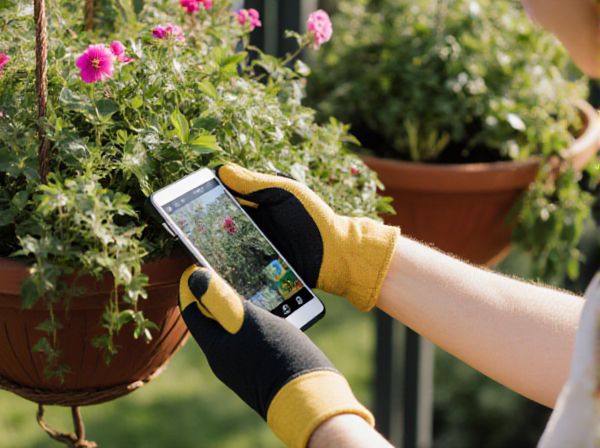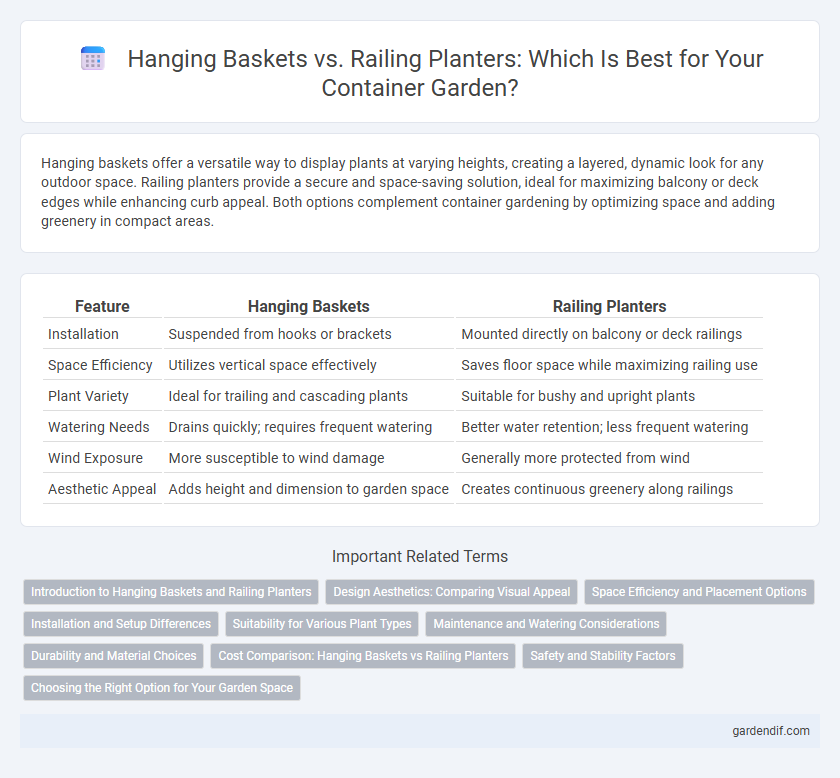
Hanging baskets vs railing planters Illustration
Hanging baskets offer a versatile way to display plants at varying heights, creating a layered, dynamic look for any outdoor space. Railing planters provide a secure and space-saving solution, ideal for maximizing balcony or deck edges while enhancing curb appeal. Both options complement container gardening by optimizing space and adding greenery in compact areas.
Table of Comparison
| Feature | Hanging Baskets | Railing Planters |
|---|---|---|
| Installation | Suspended from hooks or brackets | Mounted directly on balcony or deck railings |
| Space Efficiency | Utilizes vertical space effectively | Saves floor space while maximizing railing use |
| Plant Variety | Ideal for trailing and cascading plants | Suitable for bushy and upright plants |
| Watering Needs | Drains quickly; requires frequent watering | Better water retention; less frequent watering |
| Wind Exposure | More susceptible to wind damage | Generally more protected from wind |
| Aesthetic Appeal | Adds height and dimension to garden space | Creates continuous greenery along railings |
Introduction to Hanging Baskets and Railing Planters
Hanging baskets offer versatile vertical gardening solutions, ideal for maximizing space while adding vibrant floral displays. Railing planters securely attach to balcony or deck railings, providing easy access to plants and enhancing outdoor aesthetics without occupying floor space. Both containers support healthy root growth with proper drainage and are suitable for various plant types, including flowers, herbs, and small vegetables.
Design Aesthetics: Comparing Visual Appeal
Hanging baskets offer a lush, cascading effect that adds vertical interest and softness to outdoor spaces, creating a visually dynamic focal point. Railing planters provide a structured, linear appearance that enhances balcony or deck edges with neat, uniform greenery or floral arrangements. Both options allow for customizable color schemes and plant varieties, but hanging baskets tend to evoke a more natural, abundant look while railing planters emphasize order and architectural integration.
Space Efficiency and Placement Options
Hanging baskets maximize vertical space, making them ideal for small balconies or patios where floor area is limited. Railing planters attach securely to balcony edges, freeing up floor space while allowing easy access for watering and maintenance. Both options enhance spatial efficiency but differ in placement flexibility, with hanging baskets suitable for ceilings and overhangs, whereas railing planters require sturdy railings for installation.
Installation and Setup Differences
Hanging baskets require secure ceiling hooks or wall brackets for installation, often needing stud anchors to support weight, while railing planters simply attach to balcony or deck railings with adjustable brackets or clamps. Hanging baskets typically involve suspending the container at a height, requiring considerations for clearance and sunlight exposure, whereas railing planters mount directly on horizontal surfaces, providing easy access for watering and maintenance. The setup of hanging baskets may involve additional hardware and tools, whereas railing planters are generally simpler to install without permanent fixtures.
Suitability for Various Plant Types
Hanging baskets suit trailing and cascading plants like petunias, fuchsias, and ivy, benefiting from good air circulation and drainage, making them ideal for blooms that need space to spread downward. Railing planters are better for compact or upright plants such as herbs, succulents, and compact flowers, offering stability and easy access to sunlight along balconies or decks. Both containers require consideration of plant weight, light requirements, and watering needs to maximize growth and aesthetic appeal.
Maintenance and Watering Considerations
Hanging baskets require frequent watering due to their exposure and fast-drying soil, often necessitating daily checks during hot weather to prevent plant stress. Railing planters typically retain moisture longer because of their larger soil volume and sheltered positioning, reducing watering frequency. Maintenance for hanging baskets involves regular draining and repositioning to avoid damage, whereas railing planters allow easier access for pruning and fertilizing, simplifying overall care.
Durability and Material Choices
Hanging baskets are often crafted from lightweight materials such as plastic or resin, providing durability against weather elements while being easy to move and maintain; metal options add sturdiness but may require rust protection. Railing planters typically use heavier materials like wood, ceramic, or metal, offering superior durability and stability but potentially requiring more upkeep for weather resistance. Both options offer UV-resistant and waterproof variants that enhance longevity, with material choice directly impacting lifespan and maintenance frequency in outdoor conditions.
Cost Comparison: Hanging Baskets vs Railing Planters
Hanging baskets typically cost between $15 and $50 depending on size and material, while railing planters range from $25 to $70 due to their structural design and mounting features. Maintenance expenses for hanging baskets may be slightly higher as they often require more frequent watering and soil replacement, whereas railing planters benefit from better soil retention reducing long-term care costs. Choosing the appropriate option depends heavily on budget constraints and specific outdoor space configurations.
Safety and Stability Factors
Hanging baskets often require secure ceiling hooks and sturdy support to prevent falls, making safety installation crucial, especially in windy outdoor environments. Railing planters provide enhanced stability by resting directly on balcony or deck railings, reducing the risk of tipping but necessitating proper fastening to avoid accidents. Choosing between the two depends on the structural integrity of mounting points and the planter's weight capacity to ensure safe and stable container gardening.
Choosing the Right Option for Your Garden Space
Hanging baskets maximize vertical space, offering vibrant floral displays without occupying ground area, ideal for small gardens or balconies. Railing planters provide stability and are perfect for narrow ledges, enhancing safety while supporting cascading plants that soften fence or balcony edges. Selecting between them depends on available space, desired plant types, and the garden's structural features to ensure optimal growth and aesthetic appeal.
Hanging baskets vs railing planters Infographic

 gardendif.com
gardendif.com